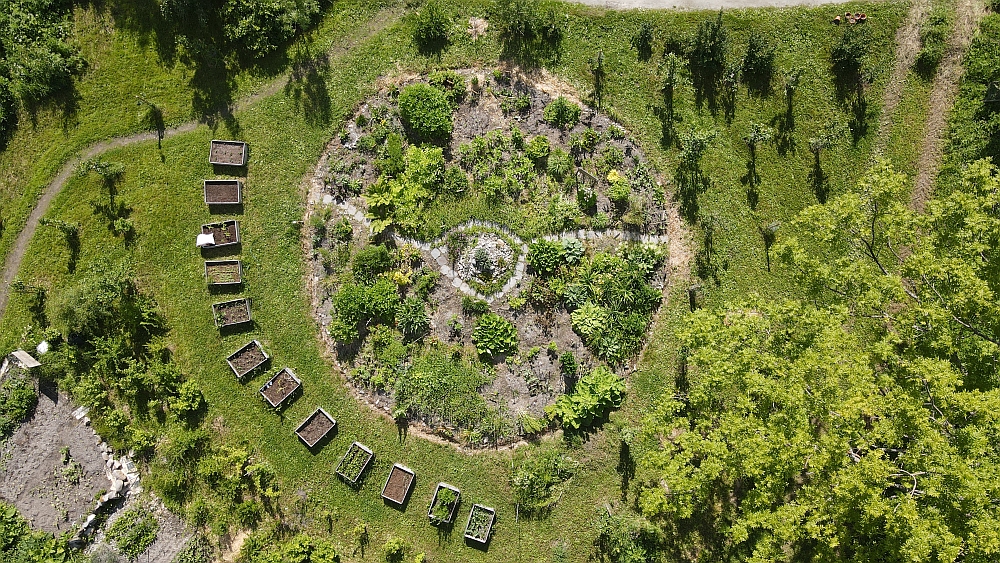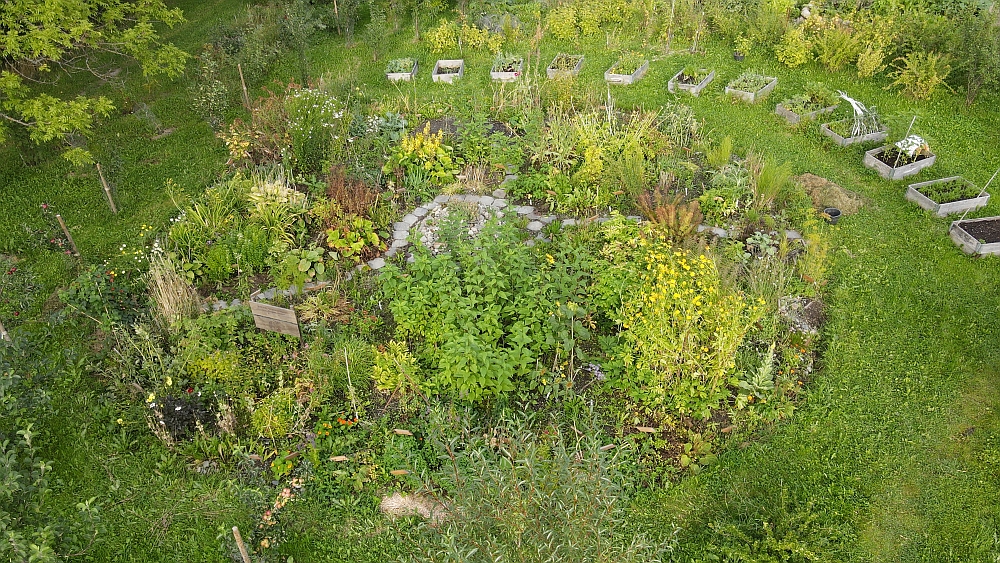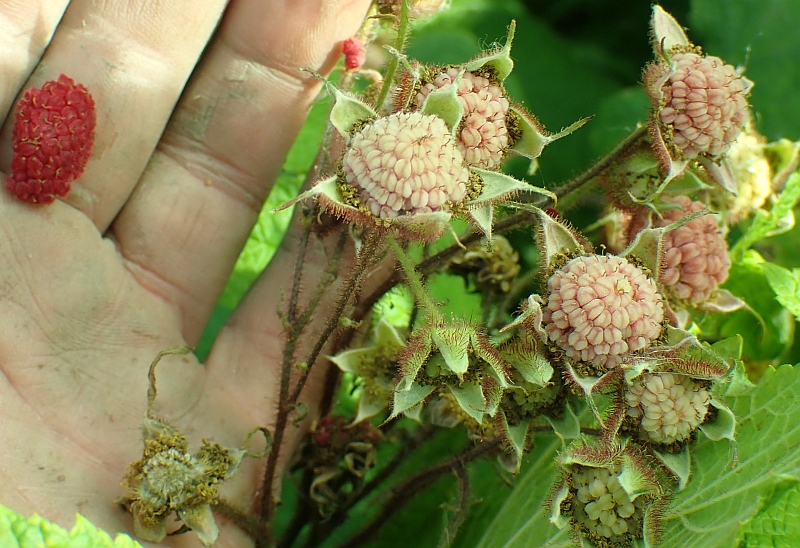1st June 2025: The view is beautified this week by the amazing floriferousness of my two Aroma apple trees. Every year I say I’ve never seen so many flowers so I’ll say it again: “I’ve never seen so many flowers” 😉


Tag Archives: Edimentals
The year’s first salad photo shoot!
The year’s first multispecies salad made earlier this week on 12th April! The list of plants is below the pictures.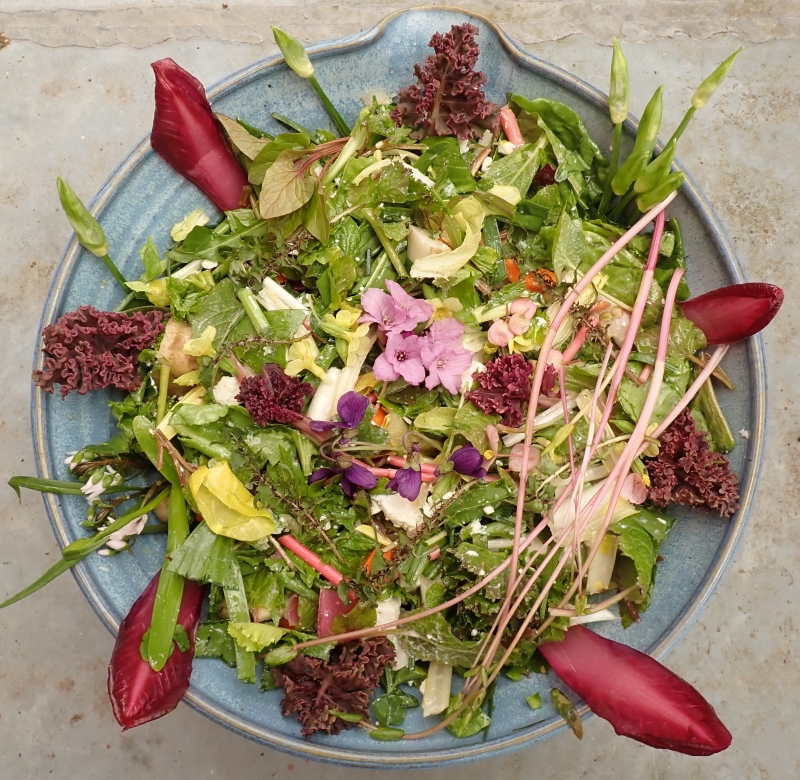
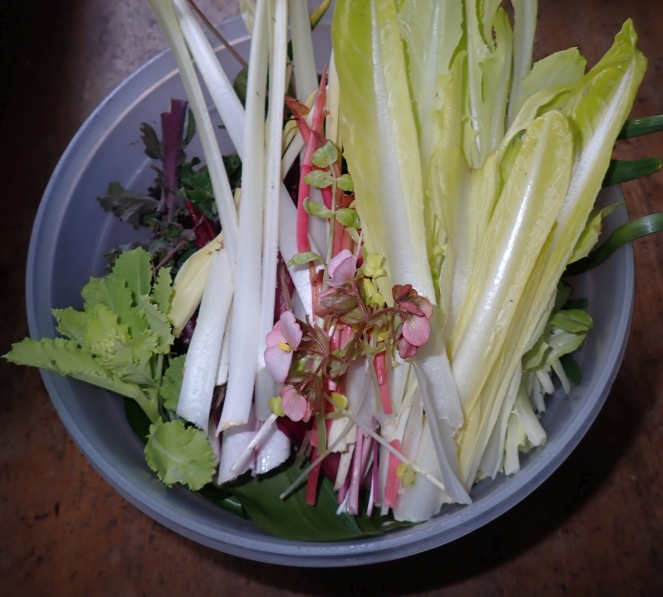

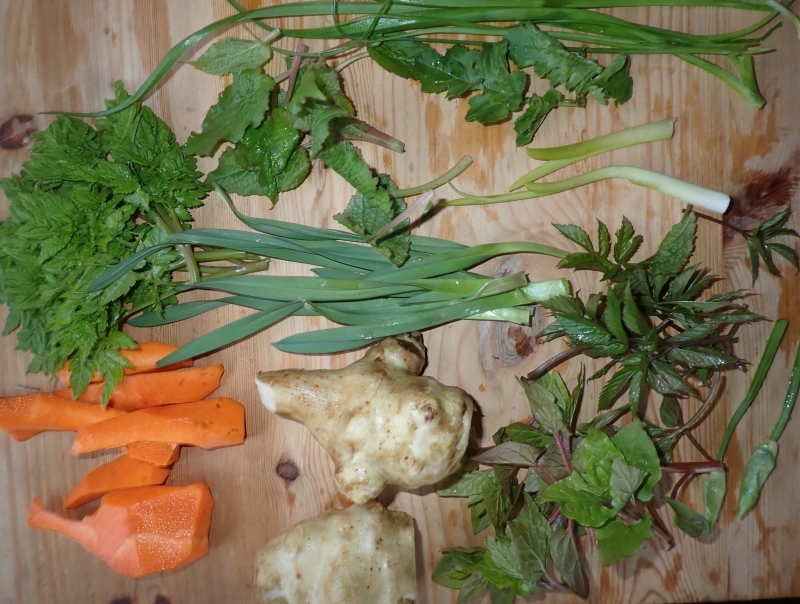

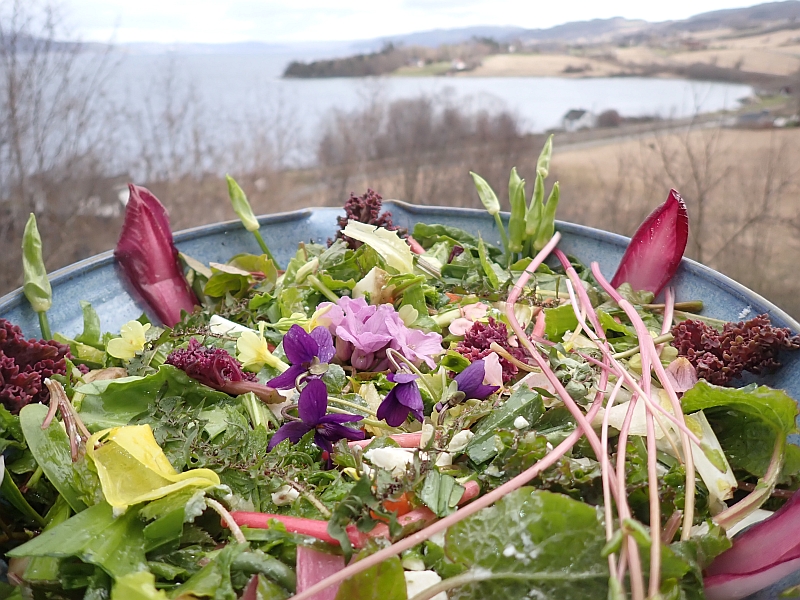
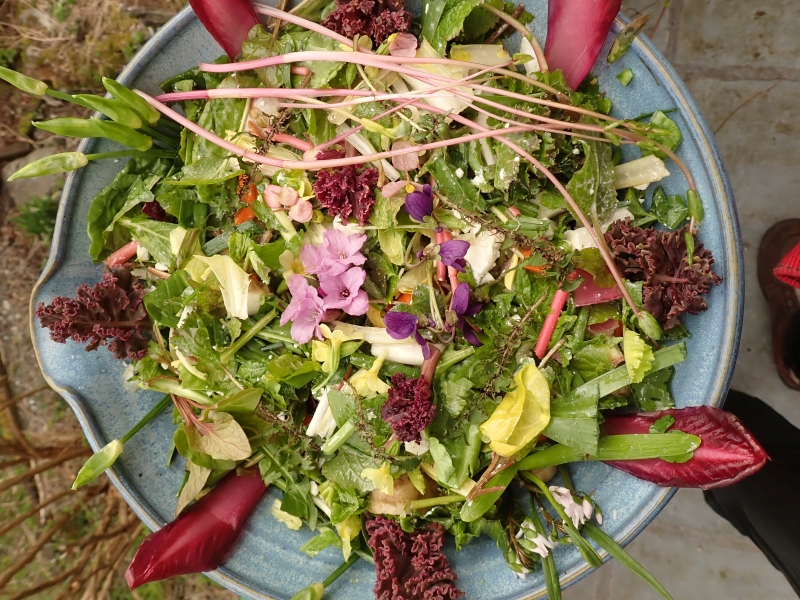
 The ingredients:
The ingredients:
Rumex patientia (patience dock / hagesyre)
Rumex acetosa “Abundance”(sorrel /engsyre)
Dystaenia takesimana (Ulleung perennial celery)
Allium paradoxum var normale (flower shoots and buds)
Allium paradoxum var paradoxum (flower shoots and buds)
Allium hymenorhizum
Claytonia virginica (spring beauty; flowers and leaves)
Cardamine pentaphyllos (flowers)
Crambe maritima (sea kale / strandkål)
Artemisia dracunculus “German tarragon” (tysk estragon)
Cichorium intybus “Perennial mix” (chicory / sikori)
Cichorium intybus “Red Treviso” (chicory / sikori)
Brassica oleracea (3 varieties of perennial kale which have overwintered well)
Alliaria petiolata (hedge garlic / løkurt)
Viola odorata (flowers)
Scorzonera hispanica shoots (blanched in the dark cellar)
Nasturtium officinale (watercress)
Allium sativum (garlic shoots and bulbs)
Sedum sp.
Houttuynia cordata (Himalayan water creeper)
Begonia heracleifolia var nigricans (flowers)
Sium sisarum (long shoots from the cellar) (skirret / sukkerrot)
Taraxacum sp. (wild dandelion)
Primula elatior (flowers) (oxlip / hagenøkleblom)
Taraxacum tortilobum (moss-leaved dandelion)
Allium cernuum (nodding onion / prærieløk)
Angelica archangelica “Voss”
Apium nodiflorum (fool’s watercress)
Allium victorialis (victory onion / seiersløk)
Daucus carota (carrot / gulrot)
Helianthus tuberosus (Jerusalem artichoke / jordskokk)
Campanula latifolia (giant bellflower / storklokke)
Allium scorodoprasum (sand leek / bendelløk)
Cirsium sp.
Aegopodium podograria (ground elder / skvallerkål)
Allium nutans
Hablitzia tamnoides (Caucasian spinach / stjernemelde)
Allium oleraceum (wild onion / villøk)
Edimentals and Perennial Veg in the RHS The Garden magazine
I have some great news to share! My word edimentals, “invented” some 17 years ago to describe those amazing plants that are both edible and ornamental – has just gone mainstream in the UK with an 8 page article written by me and published in the April edition of the RHS magazine The Garden (600,000 circulation) and one of my multi species salads even graces the front page. On the back of various show gardens at the Chelsea Flower Show in London over the last couple of years profiling edimentals and numerous magazine articles featuring one of horticulture’s buzz words. I was contacted by the RHS last November to see if I would be interested in writing an article – who’s better than the word’s inventor to write this feature for the magazine they said!
There’s also a nice interview with Mandy Barber of The Incredible Vegetables nursery on perennial vegetables! I enclose pictures of the article and a picture of the front page. I’ve been a member of the RHS since the early 80s and, although my interest is edible plants, I’ve always enjoyed the magazine for its focus on plants. Although the focus had largely been ornamental, I recognised the edible value! With greatly increased interest in edibles and nature friendly gardening within the RHS, the magazine can only get better, so please consider joining! As I mention in the article and my book Around the World in 80 plants, my first perennial vegetable was sea kale and I bought so-called sea kale thongs (root cuttings) through an advert I read in The Garden when visiting my gardening friend Robin Allan in Hexham in the early 80s! One of those plants is still alive in my garden today.
My other portmanteau words edi-ento-mental and edi-avi-mental are still waiting for adoption! They refer of course to plants that are both edible and ornamental and either insect (e.g., pollinator) or bird friendly and there are even a few quadruple value plants that tick all 4 boxes!
Please buy my book from the publishers Permanent Publications in the UK: https://www.permanentpublications.co.uk/port/around-the-world-in-80-plants-an-edible-perennial-vegetable-adventure-for-temperate-climates-by-stephen-barstow or directly from me in Norway!
Below the pdf higher resolution article and picture below you may find an extended list of favourite edimentals suggested by my 5,000 strong Edimentals and Perennial Vegetables FB group.
Of all the perennial vegetables out there, which do you think are the tastiest?
This was the question I posed the 5,000 members of my FB group Edimentals and Perennial Vegetables, founded in 2011! This has been the most popular thread ever! These were the answers (comments by members; numbers refer to number of members mentioning the plant) :
Homesteader’s Kaleidoscope Perennial Kale Grex and Taunton Deane kale (4), asparagus (4), Toona sinensis, yellow daylily (flower buds) (2), skirret (6), sea kale (shoots and broccolis) (4), Aralia elata (in tempura), cow parsnip (Heracleum maximum; young leaves and flower stalks) (2), Hosta shoots and young leaves (4), Japanese bladdernut Staphylea bumalda (leaves and flower buds), hop (shoots), garlic chives, Campanula takesimana (leaves; Korean bellflower) (2), Tilia sp. (young leaves) (2), marshmallow (shoots; Althaea officinalis), Rhus typhina (peeled shoots; staghorn sumac), Typha sp. (bulrush: shoots and rhizomes), groundnut (Apios americana) (4), Babington’s leek and other wild leeks (2), crosnes (Chinese artichokes) (3), Turkish rocket (broccolis), Hablitzia tamnoides (raw or sauteedI “SO much easier than growing spinach”) (3), any Allium, Maximilian Sunflower (Helianthus maximiliani), sorrels (4), good king henry (spinach), Jerusalem artichokes (lactofermented or roasted) (3), Mertensia maritima, globe artichokes (3), cardoon (leaf ribs), nettles (5), Rudbeckia laciniata (sochan) (2), Scorzonera hispanica (shoots and flower buds) (3), rhubarb (in dahl) (2), Lilium sp. (bulbs in soups and roasted), Malva moschata (musk mallow; leaves), Allium cepa “Perutile” (everlasting onion, growing on an Edinburgh allotment for 100 years!), Angelica archangelica, ramsons (2), chicory, Allium triquetrum, Valeriana officinalis, Napaea dioica (glade mallow), Phytolacca americana (pokeweed; properly prepared), red valerian (shoots), sea beet (leaves), bladder campion (shoots), ground elder, Taraxacum sp. of course (its rich and complex flavour knows no equal; incl. roots) (4), chayote (2), pignut, greater pignut (Bunium bulbocastanum), Sonchus arvensis (I snack on the bittersweet flower buds all summer, can’t resist them), rock samphire (Crithmum), water lotus and water chestnuts (3), alexanders (young shoots; Smyrnium), Canna edulis (2), taro (Colocasia) (2), yacon, Sagittaria (duck potatoes), Hibiscus, honewort (Cryptotaenia canadensis), fool’s watercress (Apium nodiflorum), Chinese yam (Dioscorea polystachya), Basella, Asclepias incarnata (swamp milkweed; pods), loroco (Echites panduratus), Cardamine raphanifolia, sweet cicely (Myrrhis odorata), Sanguisorba minor, Dystaenia takesimana (seombadi)
Edimentals at Kew Gardens; April 2024
An edibles walk and talk to myself at Kew Gardens on 12th April 2024!
Pictures of spotted edimentals and other edibles below (names with the pictures):
Video of A Virtual Edimentals Walk Around Burnley Gardens
My zoom talk “A Virtual Edimentals Walk Around Burnley Gardens” in Melbourne, Australia was recorded and is now available
https://youtu.be/rHX3q3Dng4k
I based the talk on Edimentals that can be grown in Melbourne, based on plant lists for Burnley Gardens and the Royal Botanical Gardens in Melbourne!
After the talk, Sam Taylor and his team made a salad from plants growing in the garden! See pictures below.
Thanks for inviting me, it was fun to put this together, and thanks for allowing me to put the recording of this unique talk up on my youtube channel!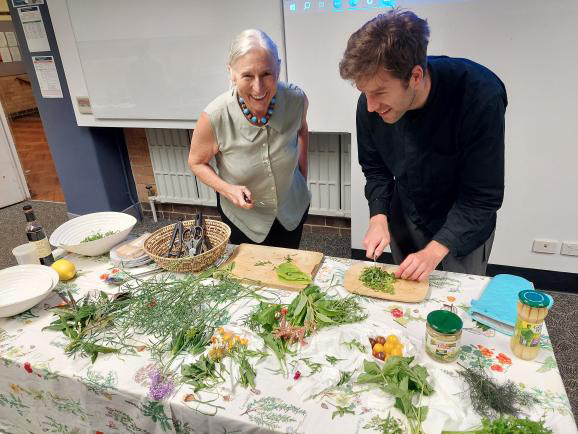
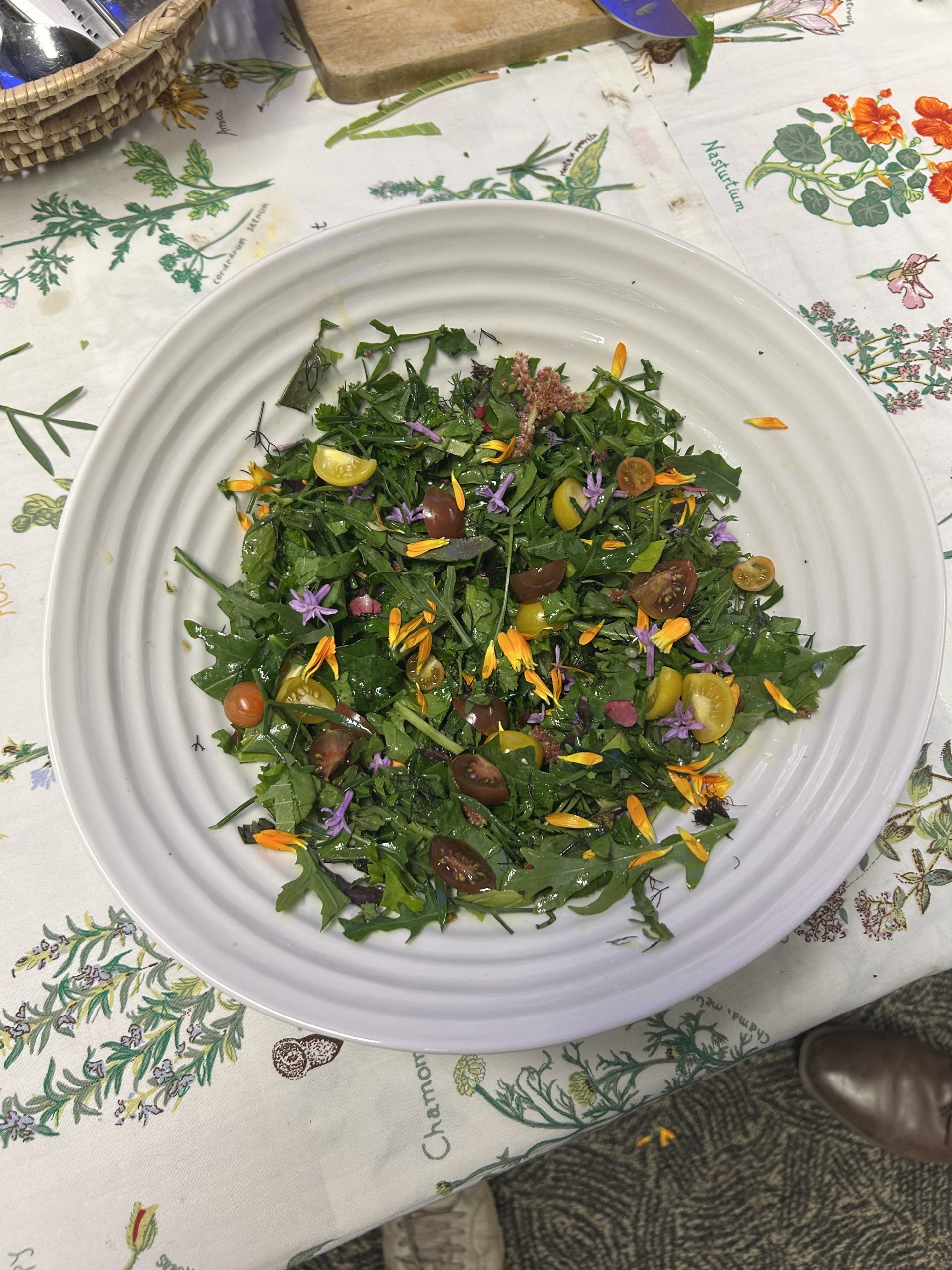
Plant list for The World Garden

I’ve shared my list of plants that I’ve planted in Trondheim’s World Garden to a few people who’ve asked and now it’s available to anyone who is curious (follow the link).
The World Garden (Verdenshagen) is a garden I’ve created, starting in 2017, to show off the diversity of perennial vegetables, essentially my book Around the World in 80 Plants as a formal garden. Many are edimentals, edientomentals and ediavimentals (i.e, edimentals that are also useful to insects and birds respectively) and demonstrates how growing food can both look good and promote a large biodiversity. The plants are placed geographically around a 12m diameter circle with the centre representing the North Pole, where edibles from arctic and mountain regions of the world are planted.
A few are annuals or biennials, planted in the gaps as the perennials grow and expand. For those of you who like lists, a list of the 359 plants I’ve planted so far is included below the new drone pictures taken in 2024! (thanks to board member Dan Smith). NB! A few of the plants have died, so this isn’t a list of current plants in the garden! I’ve noted this in the list. In addition, a few are planted each spring and overwintered indoors, such as some of the South American tuber crops.
PLANTED IN THE WORLD GARDEN (as of January 2025)
Acanthopanax sessiliflorum (syn Eleutherococcus sessiliflorus); Korean Ginseng
Aegopodium podograria Variegata; Ground elder; Skvallerkål
Agastache foeniculum ; Anise Hyssop; Anisisop
Agastache foeniculum Aureum; Golden Anise Hyssop; Anisisop
Agastache spp.; ;
Alcea ficifolia; ;
Alcea rosea ; Hollyhock; Stokkrose
Allium altissimum “Goliath”; Persian shallot ; Persisk sjalott
Allium ampeloprasum “Elephant Garlic”; Elephant Garlic; Elefanthvitløk
Allium ampeloprasum “Oerprei”; ;
Allium ampeloprasum “Perennial Leek”; Perennial leek;
Allium ampeloprasum “Perennial”?; Perennial leek;
Allium ampeloprasum “Porrum”; Leek; Purre
Allium ampeloprasum var babingtonii; Babington’s Leek;
Allium angulosum x nutans “Norrlandsløk”; Norrland onion; Norrlandsløk
Allium carolinianum ; ;
Allium cernuum “Alan Kapuler”; Nodding onion; Prærieløk
Allium cernuum “Dwarf White”; Nodding onion; Prærieløk
Allium cernuum Miks; Nodding onion; Prærieløk
Allium cernuum Tall; Nodding onion ; Prærieløk
Allium douglasii; Douglas’ Onion;
Allium fistulosum “Ishikura”; Welsh onion; Pipeløk
Allium fistulosum “Nedre Gjetsiden”; Welsh onion; Takløk fra Gudbrandsdalen
Allium flavum “Blue Leaf” ; ;
Allium flavum tauricum; Small Yellow Onion; Doggløk
Allium hookeri var muliense; ;
Allium humile; ;
Allium karataviense; ;
Allium lusitanicum; ; Kantløk
Allium macranthum “Album”; ;
Allium moly; Golden Garlic; Lili Leek; Gull-løk
Allium nutans “Esmee” ; Blue Chives; Sibirsk nikkeløk
Allium nutans “Seedlings” ; Blue Chives; Sibirsk nikkeløk
Allium obliquum; Twistedleaf Garlic; Tvistebladløk
Allium ochotense (Allium ulleungense?); ;
Allium ochotense (syn Allium victorialis); Victory onion; Seiersløk
Allium pskemense; ;
Allium pskemense x fistulosum; Wietse’s onion; Wietsesløk
Allium sativum “Aleksandra”; Garlic; Hvitløk
Allium sativum “Arkus”; Garlic; Hvitløk
Allium sativum “Belarus”; Garlic; Hvitløk
Allium sativum “Cledor”; Garlic; Hvitløk
Allium sativum “Dukat”; Garlic; Hvitløk
Allium sativum “Estisk Rød”; Garlic; Hvitløk
Allium sativum “German Hardneck”; Garlic; Hvitløk
Allium sativum “Ljubasha”; Garlic; Hvitløk
Allium sativum “Lochiel”; Garlic; Hvitløk
Allium sativum “Morado”; Garlic; Hvitløk
Allium sativum “Ornac”; Garlic; Hvitløk
Allium sativum “Romania”; Garlic; Hvitløk
Allium sativum “Tia Pink”; Garlic; Hvitløk
Allium sativum “USSR Rocambole”; Garlic; Hvitløk
Allium sativum “Valdres”; Garlic; Hvitløk
Allium sativum “Vallelado”; Garlic; Hvitløk
Allium sativum “Ävrö”; Garlic; Hvitløk
Allium schoenoprasum Alba; Chives; Gressløk
Allium schoenoprasum Dwarf; Chives; Gressløk
Allium schoenoprasum ssp boreale “Bente Marie Antonsen”; Siberian chives; Sibirgressløk
Allium scorodoprasum “Sandøy”; Sand leek; Bendelløk
Allium scorodoprasum “Abrahamsplassen, Lysthushaugen, Store Milde”; Sand leek; Bendelløk
Allium scorodoprasum “Borøya”; Sand leek; Bendelløk
Allium scorodoprasum “Gotland”; Sand leek; Bendelløk
Allium scorodoprasum “Homborsund fyr, Store Grønningen”; Sand leek; Bendelløk
Allium scorodoprasum “Leikerøya”; Sand leek; Bendelløk
Allium scorodoprasum “Møvik”; Sand leek; Bendelløk
Allium senescens ; ;
Allium sphaerocephalon; ;
Allium stipitatum; Persian shallot ; Persisk sjalott
Allium stipitatum “Mount Everest” ; Persian shallot ; Persisk sjalott
Allium ursinum; Ramsons; Ramsløk
Allium validum; Pacific onion; Stillehavsløk
Allium victorialis; Alpine Leek; Seiersløk
Allium victorialis “Nordland” ; Victory onion; Seiersløk
Allium wallichii Miks; Jimbur; Nepal-løk
Allium x cornutum ; ;
Allium x proliferum ; Walking onion; Luftløk
Allium x proliferum “5-Etasjers”; Walking onion; Luftløk
Allium x proliferum “Dømmesmoen”; Walking onion; Luftløk
Allium x proliferum “Labråten”; Walking onion; Luftløk
Allium x proliferum “Lachmanns Vei”; Walking onion; Luftløk
Allium x proliferum “Landeskogen Tuberkulose Sanatorie, Grendi”; Walking onion; Luftløk
Allium x proliferum “Lindesnes Fyr”; Walking onion; Luftløk
Allium x proliferum “Malvik, Trøndelag”; Walking onion; Luftløk
Allium x proliferum “Merete Lauen”; Walking onion; Luftløk
Allium x proliferum “Sunnfjord Folkemuseum”; Walking onion; Luftløk
Allium x proliferum “Tord Kvitrud”; Walking onion; Luftløk
Allium x proliferum “Tungenes Fyr”; Walking onion; Luftløk
Allium zebdanense; ;
Anchusa “Loddon Royalist”; ;
Anethum graveolens ; Dill; Dill
Anethum graveolens “Bouquet”; Dill; Dill
Angelica acutiloba ; ;
Angelica archangelica ssp archangelica v. Majorum “Vossakvann Markusteigen”; Angelica; Vossakvann
Angelica gigas; Korean Angelica/Giant Angelica; Rødkvann
Angelica keiskei; Ashitaba; (Not hardy, overwintered inside)
Anredera cordifolia; Madeira Vine (Not hardy, overwintered inside)
Anthriscus cerefolium ; Chervil; Hagekjørvel
Anthriscus sylvestris “Golden Fleece”; Cow parsley; Hundekjeks
Apium graveolens “Blush”; Celery ; Selleri
Apium nodiflorum; Fool’s Water-cress; European Marshwort;
Aquilegia caerulea (syn. coerulea); Rocky Mountain Columbine; Himmelakeleie
Aquilegia canadensis ; Wild Columbine; Kanadaakeleie
Arabis alpina; Alpine rock cress; Fjellskrinneblom
Aralia californica; ;
Aralia cordata ; Udo; Udo
Aralia cordata “Sun King”; Udo; Udo (died)
Aralia cordata var. sachalinensis; Udo; Udo
Aralia elata; Japanese Angelica Tree; Høstaralia
Aralia schmidtii; ;
Arctium lappa “Være Miks”; Great Burdock; Storborre
Artemisia dracunculus sativa “German”; German Tarragon; Tysk estragon
Asclepias incarnata “Soulmate”; Swamp Milkweed;
Asparagus officinalis ; Asparagus; Asparges
Asparagus officinalis “3lb Coffee Can”; Asparagus; Asparges
Asparagus officinalis “Meg’s Asparagus” ; Asparagus; Asparges
Asparagus officinalis “Purple Passion”; Asparagus; Asparges
Asparagus officinalis “Ringve”; Asparagus; Asparges
Asparagus officinalis “Tobacco box”; Asparagus; Asparges
Aster macrophylla “Twilight”; Big leaf aster;
Aster ovatus var yezoensis “Hakikomi Fu” (now Aster microcephalus);
Aster scaber; ;
Aster scaber “Ki Hakikomi Fu”; ;
Aster yomena; ;
Atriplex hortensis “Lille Næstved Skole” NGB26130; Orach; Hagemelde
Begonia aff. sinensis BWJ8133; (Not hardy, overwintered inside)
Begonia miks (Colden Common); (Not hardy, overwintered inside)
Begonia Plantearven #30; (Not hardy, overwintered inside)
Bistorta officinalis; Bistort; Ormerot
Bistorta officinalis ssp pacifica “Hakikomi Fu”; Bistort; Ormerot
Brassica juncea “Giant Red”; Mustard Greens; Sennepsalat
Brassica oleracea “Couve de Estaca” ; Perennial Kale; Flerårig Kål
Brassica oleracea “Daubenton x Late Purple Sprouting Brokkoli / Low” ; Perennial Kale; Flerårig Kål
Brassica oleracea “Daubenton-like” ; Perennial Kale; Flerårig Kål
Brassica oleracea “Ehwiger Kohl” (syn “Eiiwig Moes”); Ehwiger cabbage;
Brassica oleracea “Homesteader’s Kale” ; Perennial Kale; Flerårig Kål
Brassica oleracea “Taunton Deane”; Ehwiger cabbage; Flerårig Kål
Brassica oleracea “Tree Collard” ; Perennial Kale; Flerårig Kål
Calendula officinalis ; Pot Marigold; Ringblomst
Calochortus palmeri; Palmer’s mariposa lily, Strangling mariposa;
Camassia cusickii “Zwanenburg”; Cusick’s Quamash; Stjernehyasint
Camassia quamash; Small Camas;
Camassia quamash “Orion”; Small Camas;
Campanula latifolia Ex-“Gloaming”; Giant Bellflower; Storklokke
Campanula latifolia Ex-“Lotzes Dark Bells”; Giant Bellflower; Storklokke
Campanula punctata “Alba”; ;
Campanula punctata “Beetroot / Rubrifolia”; Chinese Rampion; Prikk-klokke
Canna “Solveig Bakken”;(Not hardy, overwintered inside)
Canna edulis var warszewiczii (syn. Canna indica); Indian Shot; Queensland arrowroot; (Not hardy, overwintered inside)
Capsella bursa-pastoris; Shepherd’s Purse; Gjetertaske
Carum carvi “Caraway Root” from Malvik; Caraway; Karve
Chaerophyllum bulbosum “Doreene”; Turnip-rooted Chervil; Knollkjeks (died)
Chenopodium ambrosioides ; Epazote; Sitronmelde (Not hardy, overwintered inside)
Chrysanthemum coronarium “Double” CHRY69; Shungiku; Chopsuey Greens; Shungiku; Kronkrage
Chrysanthemum coronarium CHRY67 (Single flowered); Shungiku; Chopsuey Greens; Shungiku; Kronkrage
Chrysanthemum coronarium Double; Shungiku; Chopsuey Greens; Shungiku; Kronkrage
Chrysanthemum coronarium Double White; Shungiku; Chopsuey Greens; Shungiku; Kronkrage
Chrysanthemum segetum ; Corn Marigold; Gullkrage
Cichorium intybus; Chicory; Sikkori
Cichorium intybus “Soncino” iPK; Chicory; Sikkori
Cichorium intybus “Witloof Væres Venner”; Chicory; Sikkori
Cirsium canum; Queen Anne’s Thistle;
Cirsium eriophorum; Wooly Thistle; Ulltistel
Cirsium occidentale; Cobweb thistle;
Cirsium oleraceum; Siberian Thistle/Cabbage Thistle; Kåltistel
Cirsium rivulare “Atropurpureum”; ;
Cirsium tuberosum ; Tuberous Thistle; Knolltistel
Codonopsis ovata; ;
Codonopsis pilosula ; Dang Shen; Dang Shen
Coix lacryma-jobi “Mekong”; Job’s Tears; Jobståre
Conopodium majus; Pignut; Jordnøtt
Coriandrum sativum; Coriander; Koriander
Crambe cordifolia; Heartleaf Crambe; Buskstrandkål
Crambe maritima “Lily White” ; Sea kale; Strandkål
Crambe orientalis; ;
Crithmum maritimum; Rock Samphire; Sanktpeterskjerm (Not hardy, overwintered inside)
Cryptotaenia canadensis; Honewort;
Cryptotaenia japonica ; Mitsuba; Japanese Parsley; Mitsuba; Japansk Persille
Cryptotaenia japonica “Dosaka Shiroguki” CRY1; Mitsuba; Japanese Parsley; Mitsuba; Japansk Persille
Cryptotaenia japonica Atropurpurea; Mitsuba; Japanese Parsley; Mitsuba; Japansk Persille
Cynara scolymus “Vert de Leon” ; Artichoke; Artiskokk (Not hardy, overwintered inside)
Cyperus esculentus; Tiger Nuts/Chufa; Matkypergras (Not hardy, overwintered inside)
Dahlia “Bishop of Dover”; (Not hardy, overwintered inside)
Dahlia “Bishop of Llandaff”; (Not hardy, overwintered inside)
Dahlia “Bløtkake”; (Not hardy, overwintered inside)
Dahlia “Yellow Sneezy”; (Not hardy, overwintered inside)
Dahlia pinnata “Festival”; ;
Diplotaxis tenuifolia “Wild Rocket Wildfire”?; Perennial Wall-rocket ; Steinsennep
Dystaenia takesimana; Giant Ulleung Celery
Elatostema umbellata; ; (died)
Elsholtzia elata; Crested Late Summer-Mint; Kammynte
Fagopyrum dibotrys; Perennial Buckwheat; Flerårig Bokhvete (died)
Fagopyrum tataricum FAG98; Tartarian Buckwheat; Vill Bokhvete
Foeniculum vulgare “Bronze”; Fennel; Fennikel (died)
Fritillaria camschatcensis; Kamchatka Lily/Rice Lily; Svartlilje
Fuchsia magellanica; Hardy Fuchsia; Magellan-tåre
Glycyrrhiza glabra ; Licquorice; Lakrisrot (not all varieties have survived)
Glycyrrhiza glabra GLY18; Licquorice; Lakris
Glycyrrhiza glabra var glabra GLY23; Licquorice; Lakris
Glycyrrhiza glabra var glabra GLY8; Licquorice; Lakris
Glycyrrhiza glabra var glandulifera GLY1; Licquorice; Lakris
Glycyrrhiza glabra var glandulifera GLY7; Licquorice; Lakris
Hablitzia tamnoides; Hablitzia; Caucasian spinach; Stjernemelde
Helianthus annuus “Dwarf Yellow”; Sunflower; Solsikke
Helianthus annuus “Short Russian”; Sunflower; Solsikke
Helianthus strumosus “Herman”?; ;
Helianthus tuberosum “Bianca”; Jerusalem Artichoke; Jordskokk
Helianthus tuberosum “Dagnøytral Form”; Jerusalem Artichoke; Jordskokk
Helianthus tuberosum “Dagnøytral x Karl Aakerro’s Northern accessions; Jerusalem Artichoke; Jordskokk
Helianthus tuberosum “Dwarf Sunray”; Jerusalem Artichoke; Jordskokk
Helianthus tuberosum “Dwarf”; Jerusalem Artichoke; Jordskokk
Helianthus tuberosum “Fuseau”; Jerusalem Artichoke; Jordskokk
Helianthus tuberosum “Long Smooth”; Jerusalem Artichoke; Jordskokk
Helianthus tuberosum “NC-202”; Jerusalem Artichoke; Jordskokk
Hemerocallis; ;
Hemerocallis altissima; Day Lily; Daglilje
Hemerocallis citrina; Day Lily; Daglilje
Hemerocallis dumortieri; ;
Hemerocallis middendorfii; ;
Hemerocallis spp. ; ;
Hemerocallis spp. #2; Daylily; Daglilje
Heracleum sphondylium “Pink flowered”; Hogweed; Kystbjørnekjeks
Hosta “Blue Angel”; ;
Hosta “Empress Wu”; ;
Hosta montana?; ;
Hosta nigrescens; ;
Hosta sieboldiana “Big Daddy”; Plantain-Lily; Dugg-bladlilje
Hosta sieboldiana “Elegans”; ;
Humulus lupulus; Hops; Humle (Wild from Wisconsin)
Humulus lupulus Aureus ; Golden Hops; Gullhumle
Hydrophyllum appendiculatum; Great Waterleaf;
Hydrophyllum tenuipes; Pacific waterleaf, Slender-stem waterleaf;
Hydrophyllum virginianum; Eastern Waterleaf; Virginia Waterleaf;
Kalimeris pinnatifida “Hortensis” ; ;
Kalimeris yomena “Shogun”; ;
Laportea bulbilifera; ; (died)
Laportea canadensis ; Canadian Wood Nettle;
Lathyrus sativus; Chickling Pea; Fôrskolm
Levisticum officinale “Ullershov”; Lovage; Løpstikke
Lewisia longipetala x cotyledon “Little Plum”; ;
Lewisia pygmaea; Pygmy Bitterroot, Alpine Lewisia, Dwarf Lewisia ; Dverglewisia
Lewisia rupicola (syn Lewisia columbiana var rupicola); Columbian Lewisia; Columbian Bitteroot
Ligularia fischeri; Fischer’s Ligularia; Fischersnøkketunge
Ligularia fischeri “Vill fra Himalaya”; ;
Ligularia fischeri var. megalorhiza “Cheju Charmer”; ;
Ligusticum canadense; American lovage, boar hog root, Canadian licorice-root;
Ligusticum grayi; Gray’s licorice-root;
Ligusticum hultenii; ;
Lilium davidii; David’s Lily; Davidslilje
Lilium henryi; ;
Lilium lancifolium; Tiger lily; Tigerlilje
Lilium martagon Miks; Martagon Lily; Martagonlilje; krøll-lilje
Lomatium dissectum; Fernleaf Biscuitroot;
Lomatium nudicaule; Pestle Parsnip ;
Lotus tetragonolobus (syn Tetragonolobus purpureus); Asparagus Pea;
Maianthemum racemosum “Emily Moody” ; False Spikenard; Toppkonvall
Malva crispa; Curly mallow; Kruskattost
Malva moschata; Musk Mallow; Moskuskattost
Malva moschata “Alba”; Musk Mallow; Moskuskattost
Malva sylvestris zebrina; Common Mallow; Apotekerkattost
Matteuccia struthiopteris ; Ostrich Fern; Strutseving
Medicago sativa ; Lucerne, Alfalfa; Blålusern
Medicago sativa “Cache Valley”; Lucerne, Alfalfa; Blålusern
Melissa officinalis ; Lemon balm; Sitronmelisse
Monarda “Cambridge Scarlet”; ;
Monarda “Pink Surprise” (Supreme); ;
Monarda fistulosa; Wild Bergamot; Rørhestemynte
Oenanthe javanica; Seri; Seri
Oplopanax horridus; Devil’s Club; (died)
Opuntia spp. ; ;
Ornithogalum pyrenaicum ; Bath Asparagus;
Osmorhiza spp.; ;
Oxalis “Ute” (O. laciniata x O. enneaphylla); ;
Oxalis acetosella “Rosea”; Wood Sorrel; Gjøksyre
Oxalis adenophylla “Minima”; ;
Oxalis tuberosa “Red”; Oca; Oca (Not hardy, overwintered inside)
Oxalis tuberosa “Yellow”; Oca; Oca (Not hardy, overwintered inside)
Papaver somniferum var setigerum ; Opium poppy; Opiumvalmue
Papaver somniferum “After Midnight”; Opium poppy; Opiumvalmue
Papaver somniferum “Sissinghurst White”; Opium poppy; Opiumvalmue
Perideridia montana; Gairdner’s Yampah ;
Petroselinum crispum ; Parsley; Persille
Petroselinum crispum “Moss Curled 2”; Parsley; Persille
Phaseolus coccineus “Attila”; ;
Phaseolus coccineus Miks; Runner Beans; Blomsterbønner, løpebønner
Phyteuma nigrum ; Black rampion; Svartvadderot
Phyteuma spicatum ; Spiked Rampion; Vadderot
Phyteuma spicatum (with blotches); Spiked Rampion; Vadderot
Phytolacca americana; Pokeweed; Kermesbær
Plantago major “Atropurpurea”; Greater Plantain; Groblad
Platycodon grandiflorus “Mixed hybrid doubles”; Balloon Flower; Flattklokke
Polygonum viviparum; Alpine bistort; Harerug
Polymnia sonchifolia (syn Polymnia edulis; from Nevi); Yacon Strawberry; Yacon (Not hardy, overwintered inside)
Primula veris ; Cowslip; Marinøkleblom
Raphanus sativus convar caudatus “Busk reddik”; Radish; Reddik
Raphanus sativus convar caudatus “Dragon’s Tail”; Radish; Reddik
Raphanus sativus convar caudatus “IPK RA765” Slangenradijs; Radish; Reddik
Raphanus sativus convar caudatus “IPK RA82”; Radish; Reddik
Raphanus sativus convar caudatus “IPK RA84”; Radish; Reddik
Raphanus sativus convar caudatus “IPK RA85”; Radish; Reddik
Raphanus sativus convar caudatus “Radish pod”; Radish; Reddik
Rheum ribes; ;
Rheum webbianum; ;
Rheum x rhabarbarum “Ex-Træna”; Rhubarb; Rabarbra
Rhodiola rosea; Roseroot; Rosenrot
Rosmarinus officinalis ; Rosemary; Rosmarin
Rudbeckia laciniata ; Cutleaf Coneflower; Gjerdesolhatt
Rudbeckia laciniata (Double); Cutleaf Coneflower; Gjerdesolhatt
Rumex acetosa “Kerti” IPK RUM22; Sorrel; Engsyre
Rumex acetosa “Champion”; Sorrel; Engsyre
Rumex acetosa “Non-flowering variety” (Profusion?); Sorrel; Engsyre
Rumex acetosa vinealis; Sorrel; Engsyre
Rumex patientia; Herb Patience; Hagesyre
Rumex rugosus RUM22; ;
Rumex scutatus “Leiden” ; Buckler-leaved Sorrel; Fransksyre
Rumex scutatus “Silver Shield” ; Buckler-leaved Sorrel; Fransksyre
Saccharum officinarum “Raglan”; Sugar Cane; Sukkerrør (Not hardy, overwintered inside)
Sagitttaria latifolia?; Wapato; Wapato
Salvia officinalis; Sage; Salvie
Saxifraga stolonifera; Creeping saxifrage, strawberry saxifrage, creeping rockfoil
Saxifraga stolonifera Dark leaves; Creeping saxifrage, strawberry saxifrage, creeping rockfoil
Schisandra chinensis “Eastern Prince”; Wu Wei Zi; Sandra Berry; Schisandra;
Secale cerale “Mountaineer Perennial”; Rye; Rug
Sedum sarmentosum; ;
Sideritis hyssopifolia; ;
Sideritis syriaca; Greek mountain tea; Gresk fjellte
Silene vulgaris “Rosea”; Bladder Campion, Maiden’s Tears; Engsmelle
Silene vulgaris “Variegata”; Bladder Campion, Maiden’s Tears; Engsmelle
Silybum marianum “Adriana”; Milk Thistle; Mariatistel
Sium sisarum ; Skirret; Sukkerrot
Sium sisarum “Improved”; Skirret; Sukkerrot
Taraxacum “Pissenlit Ameliore Coeur Plein” IPK TARA11; Moss-leaved Dandelion; Mosebladet løvetann
Taraxacum albidum; ;
Taraxacum coreanum; ;
Taraxacum leucanthum ; ;
Taraxacum pseudoroseum; Pink flowered dandelion; Rosablomstret løvetann
Taraxacum tortilobum ; Moss-leaved Dandelion; Mosebladet løvetann
Tetragonia tetragonoides; New Zealand Spinach; Ny Zealandsk spinat (Not hardy, overwintered inside)
Tigridia pavonia; Tiger flower; Ny Zealandsk spinat (Not hardy, overwintered inside)
Tradescantia occidentalis; Prairie Spiderwort;
Tradescantia (Andersoniana Group) ‘Sweet Kate’; ;
Tragopogon balcanicus; ;
Tragopogon orientalis; ;
Trillium erectum “Burgundy”; Beth Root
Tropaeolum majus all; Nasturtium; Vanlig blomkarse
Tropaeolum tuberosum “Ken Aslet”; Mashua; Knollblomkarse (Not hardy, overwintered inside)
Tropaeolum tuberosum “White tubers”; Mashua; Knollblomkarse (Not hardy, overwintered inside)
Urtica dioica “Stingless Form Group” #2; Stinging nettle ; Brennesle
Urtica gracilis (syn Urtica dioica gracilis); Stinging Nettle, California Nettle;
Vicia faba; Broad beans; Bondebønner
Vicia faba “Oldamster Wierdeboon”; Broad beans; Bondebønner
Vicia faba major “Fingerprint Fava”; Broad Beans; Bondebønne
Vicia faba major “Red Cheek Fava”; Broad Beans; Bondebønne
Vicia faba major “Small Black”; Broad Beans; Bondebønne
Vicia faba major “The Sutton”; Broad Beans; Bondebønne
Vicia narbonensis; ;
Zingiber mioga ; Myoga, Myoga ginger, Japanese Ginger; (died)
Mid-January Salad
In connection with Cathrine Kramer’s (Centre for Genomic Gastronomy) third visit to Malvik from her base in Amsterdam to make an around the year artistic film of The Edible Garden, I made a winter salad to show what is currently available to harvest in the living room, cellar and outside.
Living rooms: forced Witloof chicories / sikori (my own Væres Venner community garden grex), Allium senescens hybrid perennial onion, forced wild dandelions / løvetann, cress / karse and wild buckwheat / villbokhvete sprouts (in sterlised soil), garlic bulbil sprouts, Begonia flowers, oca (2 varieties), parsley / persille, watercress / engelsk karse, Allium triquetrum shoots, garlic / hvitløk, Plectranthus amboinicus (Cuban oregano) and the last of the tomatoes / tomat!
From the cellar: carrots / gulrot, swede / kålrot, 3 varieties turnip / nepe, Jerusalem artichoke / jordskokk, apple /eple, sea kale / strandkål (roots dug in the autumn that had sprouted in the warmer than normal cellar), 2-3 varieties celery, beetroot / rødbete “Chioggia”, wild chicory / vill sikori (Cichorium intybus), 4 salad chicories and perennial kale shoots.
Outside: Caucasian spinach / stjernemelde (Hablitzia tamnoides), several dandelion species (leaves and flower buds) and Chicago onion / prærieløk (Allium cernuum).
North American Forest Garden
On the Eastern boundary at the Væres Venner community garden in Trondheim, I wanted to develop a small forest garden devoted to edible plants of the first peoples in North America. Two years ago I planted two of them which now have berries for the first time!
They are
a) Purple flowering raspberry / rosebær (Rubus odoratus), a species which is often planted as an ornamental in Norway, usually a single clone so most are not aware that is has tasty fruit. With this in mind I germinated seed from the NARGS seed list, sown in January 2022 which germinated late May the same year and were planted out in May 2023, so just two years from seed to the first berries.
b) Black hawthorn / Douglashagtorn (Crataegus douglasii): this is given 4 out of 5 stars at https://pfaf.org/User/plant.aspx… and after my first taste I agree with their assessment: they would make a good addition to a mixed fruit salad. No wonder this berry was widely used by native americans including the Cheyenne.
I now plan to prepare the area around the trees for perennial vegetables from the same area!
EDIMENTALS VISITS RHS WISLEY
On a short visit to England to visit my mum, I visited RHS Wisley yesterday to do a 2 hour walk and talk for the Edibles Team (and a few others who were interested!). I hopefully added a new dimension to their work by pointing out all the wonderful perennial veg and other edibles hidden incognito in the ornamental collections, everything from Hostas to Rudbeckia to Gunnera!
Still getting my head around the fact that there is such a thing as an Edibles Team across the RHS gardens! Next week I’m following this up with a webinar about Edimentals for all the gardens!
…and I’d just like to congratulate the team for the World Food Garden! It’s very impressive with quite a few perennial veg already and looks and I imagine tastes fantastic!
Thanks for the warm enthusiastic welcome to leaderSheila Das and the rest of the team!
Wisley is a garden I’ve visited many times over the years to do a spot of edible spotting, so great to be able to pass on some of the knowledge!
#edimentals #edientomentals #edientoavimentals #hiddenedibles #RHSEdiblesTeam #worldfoodgarden #extremesaladman
Toad lilies: great edientomentals
Toad lilies (Tricyrtis sp.) are great edientomentals from the Far East; i.e. both food for us to eat (the edi bit), eye food (the mental bit ;) ) and food for the pollinators like bumble bees (the ento bit).
I’ve been meaning to try to research this genus properly for many years ever since I ate the young shoots 10 years ago (it tasted mild and good). I’ve tried 10+ species over the years, but only the early flowering species thrive (Tricyrtis latifolia is I think the most successful of the two). Bumble bees love them too as can be seen in the video below!
Below the pictures is an overview of how different species Tricyrtis are used in Japan. It indicates that the flowers can also be used at least in moderation for decoration, so I must give it a go!


Tricyrtis in the kitchen
All I have so far is that 6 or 7 species are listed in my comprehensive Japanese foraging book (in Japanese): Wild Food Lexicon (Japan) and this is what it says (there are no warnings of possible toxicity and it encourages the reader to get and grow a couple of the species):
Tricyrtis latifolia (Tamagawa hototogisu)
Eat young shoots. You can eat other types of Tricyrtis so don’t worry if you make a mistake. Rest assured. You can pick it even if the stems are long, you can pick the soft young shoots until they bloom.
Boil in hot water with a pinch of salt, then rinse in cold water. In boiled food, soup, tempura…
Tricyrtis macropoda
It can be eaten like Tamagawa hototogisu, but the ones with a lot of hairs have an inferior taste.
Tricyrtis macrantha
Boiled soup. For tempura etc. It has a crisp texture. Boil briefly, soak in cold water, boil, cut into small pieces and season with mustard. The young shoots are the most flavourful amongst the hototogisu.
Tricyrtis macranthopsis
Seedlings for cultivation are on the market. You can grow it and use it as food.
Around May, pick young shoots that grow diagonally. Even those with long stems can be eaten by picking the soft part at the tip of the stem.
Tricyrtis perfoliata
Young shoots are “hard”? in quality. Floating the flowers in the soup and enclosing them in jelly will make them beautiful. Get it, grow it and taste it!!


































































